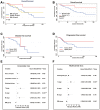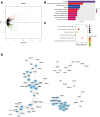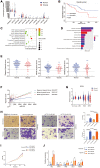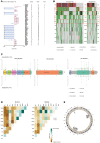Colon cancer combined with obesity indicates improved survival- research on relevant mechanism
- PMID: 33197880
- PMCID: PMC7762486
- DOI: 10.18632/aging.103972
Colon cancer combined with obesity indicates improved survival- research on relevant mechanism
Abstract
Obesity contributes to the incidence of various tumors, including colon cancer. However, the impact of obesity on patients' survival and related mechanisms remains unclear. Multi-omics data of 227 cases of colon cancer patients combined with clinical characteristics data were acquired from The Cancer Genome Atlas (TCGA) database. We confirmed obesity as an independent prognostic factor for improved overall survival of colon cancer patients. We demonstrated that hypoxia pathways were repressed in obese patients by regulating miR-210. Immune checkpoints PD-1 and LAG3 were also downregulated in obese patients, which indicated enhanced immune surveillance. The frequency of PIK3CA and KRAS mutations was decreased in obese patients. The sites and types of TP53 mutation were alternated in obesity patients. In conclusion, our research demonstrated the potential mechanisms of prolonged survival in colon cancer patients combined with obesity, which may provide potential value for improving the prognosis of colon cancer.
Keywords: TP53; colon cancer; hypoxia; immune checkpoints; obesity.
Conflict of interest statement
Figures





Similar articles
-
Identification and validation of an immune-related gene signature predictive of overall survival in colon cancer.Aging (Albany NY). 2020 Dec 19;12(24):26095-26120. doi: 10.18632/aging.202317. Epub 2020 Dec 19. Aging (Albany NY). 2020. PMID: 33401247 Free PMC article.
-
A TP53-based immune prognostic model for muscle-invasive bladder cancer.Aging (Albany NY). 2020 Dec 15;13(2):1929-1946. doi: 10.18632/aging.202150. Epub 2020 Dec 15. Aging (Albany NY). 2020. PMID: 33323544 Free PMC article.
-
Small Bowel Carcinomas in Coeliac or Crohn's Disease: Clinico-pathological, Molecular, and Prognostic Features. A Study From the Small Bowel Cancer Italian Consortium.J Crohns Colitis. 2017 Aug 1;11(8):942-953. doi: 10.1093/ecco-jcc/jjx031. J Crohns Colitis. 2017. PMID: 28333239
-
Prognostic significance of K-ras and TP53 mutations in the role of adjuvant chemotherapy on survival in patients with Dukes C colon cancer.Dis Colon Rectum. 2001 Mar;44(3):358-63. doi: 10.1007/BF02234733. Dis Colon Rectum. 2001. PMID: 11289281
-
Study of apoptosis-related interactions in colorectal cancer.Tumour Biol. 2016 Nov;37(11):14415-14425. doi: 10.1007/s13277-016-5363-9. Epub 2016 Sep 15. Tumour Biol. 2016. PMID: 27629291 Review.
Cited by
-
Prognostic value of mesorectal package area in patients with locally advanced rectal cancer following neoadjuvant chemoradiotherapy: A retrospective cohort study.Front Oncol. 2022 Oct 3;12:941786. doi: 10.3389/fonc.2022.941786. eCollection 2022. Front Oncol. 2022. PMID: 36263216 Free PMC article.
-
A New Risk-Scoring System for Colorectal Cancer and Polyp Screening by Turkish Colorectal Cancer and Polyp Study Group.Turk J Gastroenterol. 2022 Apr;33(4):286-293. doi: 10.5152/tjg.2022.21072. Turk J Gastroenterol. 2022. PMID: 35550537 Free PMC article.
-
Bioinformatic analysis of the obesity paradox and possible associated factors in colorectal cancer using TCGA cohorts.J Cancer. 2023 Jan 22;14(3):322-335. doi: 10.7150/jca.80977. eCollection 2023. J Cancer. 2023. PMID: 36860923 Free PMC article.
-
The impact of body mass index on prognosis in patients with colon carcinoma.Int J Colorectal Dis. 2022 May;37(5):1107-1117. doi: 10.1007/s00384-022-04146-2. Epub 2022 Apr 14. Int J Colorectal Dis. 2022. PMID: 35426079 Free PMC article.
-
Body mass index-based predictions and personalized clinical strategies for colorectal cancer in the context of PPPM.EPMA J. 2022 Dec 2;13(4):615-632. doi: 10.1007/s13167-022-00306-0. eCollection 2022 Dec. EPMA J. 2022. PMID: 36505896 Free PMC article. Review.
References
-
- Aleksandrova K, Pischon T, Buijsse B, May AM, Peeters PH, Bueno-de-Mesquita HB, Jenab M, Fedirko V, Dahm CC, Siersema PD, Freisling H, Ferrari P, Overvad K, et al.. Adult weight change and risk of colorectal cancer in the European prospective investigation into cancer and nutrition. Eur J Cancer. 2013; 49:3526–36. 10.1016/j.ejca.2013.06.021 - DOI - PubMed
Publication types
MeSH terms
Substances
LinkOut - more resources
Full Text Sources
Medical
Research Materials
Miscellaneous

